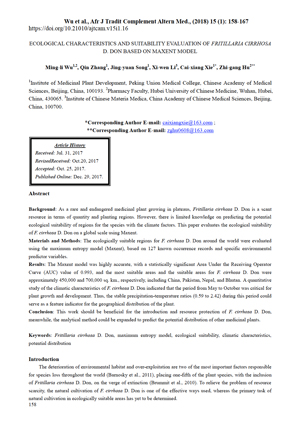NEWS 2018
Ecological Characteristics and Suitability Evaluation of Fritillaria cirrhosa D. Don based on Maxent Model
Ming-li WU1,2, Qin ZHANG1, Jing-yuan SONG1, Xi-wen LI3, Cai-xiang XIE1, Zhi-gang HU2
Afr J Tradit Complement Altern Med., 15(1): 158-167(2018)
http://dx.doi.org/10.21010/ajtcam.vi15.1.16
1Institute of Medicinal plant Development, Peking Union Medical College, Chinese Academy of Medical Sciences, Beijing, China, 100193
2Pharmacy Faculty, Hubei University of Chinese Medicine, Wuhan, Hubei, China, 430065
3Insitute of Chinese Materia Medica, Chinese Academy of Medical Science, Beijing, China, 100700
Abstract
Background: As a rare and endangered medicinal plant growing in plateaus, Fritillaria cirrhosa D. Don is a scant resource in terms of quantity and planting regions. However, there is limited knowledge on predicting the potential ecological suitability of regions for the species with the climate factors. This paper evaluates the ecological suitability of F. cirrhosa D. Don on a global scale using Maxent. Materials and Methods: The ecologically suitable regions for F. cirrhosa D. Don around the world were evaluated using the maximum entropy model (Maxent), based on 127 known occurrence records and specific environmental predictor variables. Results: The Maxent model was highly accurate, with a statistically significant Area Under the Receiving Operator Curve (AUC) value of 0.993, and the most suitable areas and the suitable areas for F. cirrhosa D. Don were approximately 450,000 and 700,000 sq. km., respectively, including China, Pakistan, Nepal, and Bhutan. A quantitative study of the climatic characteristics of F. cirrhosa D. Don indicated that the period from May to October was critical for plant growth and development. Thus, the stable precipitation-temperature ratios (0.59 to 2.42) during this period could serve as a feature indicator for the geographical distribution of the plant. Conclusion: This work should be beneficial for the introduction and resource protection of F. cirrhosa D. Don, meanwhile, the analytical method could be expanded to predict the potential distribution of other medicinal plants.




